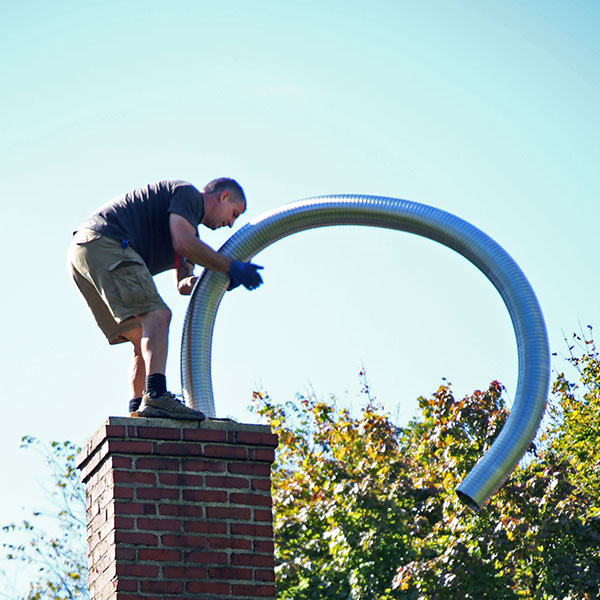Using a Chimney without a Chimney Liner?
The technicians at National Chimney Service get this question occasionally from our customers in Morris County NJ and Fairfield County CT – regions where fireplace use is usually heavy. The simple answer we give is: yes, it’s technically possible to use an unlined chimney. But no, it’s not advisable, as the chimney liner protects your chimney and other combustible areas nearby.
 What is a chimney liner?
What is a chimney liner?
Chimney liners, or flue liners, are components that are built or installed inside your chimney flue, which stretches from just above the fireplace to the top of the chimney structure.
It was common many years ago to rely on the interior bricks of a chimney to keep the system safe and efficient. By the early 1900s, advances in fire-safety understanding made it clear that a lined chimney was far superior to an unlined chimney in terms of safety and performance.
These days in most U.S. jurisdictions, chimney liners are required as part of a chimney’s construction.
Chimney liner materials
Unless you have a very old chimney that hasn’t had any maintenance or upgrades, your chimney has a liner. Common materials used for chimney liners include:
- Stainless steel
- Clay tiles
- Poured-in-place compounds
Why your chimney needs a liner
According to the Chimney Safety Institute of America (CSIA):
“In the 1940’s and again in the 1980’s, masonry chimneys were tested by the National Bureau or [sic] Standards for durability due to rising concerns about their performance and safety. The tests revealed that unlined chimneys were so unsafe that researchers characterized building a chimney without a liner as ‘little less than criminal.’”
Chimney liners serve three primary functions:
-
Protect against house fires
An unlined chimney allows intense heat and sparks (including flames from a chimney fire) to damage and possibly ignite building materials of the home near the chimney. Many house fires each year begin because of chimneys with damaged (or no) liners.
-
Protect the interior masonry
Gases created by combustion when you use your fireplace are naturally acidic and will cause major damage to the bricks and mortar they come into contact with. Eroded mortar joints and bricks will allow dangerous carbon monoxide, which is contained within combustion gases, to seep into your home without you knowing it.
-
Provide the right-sized flue for smoke drafting
Chimney liners, when installed or built properly, are sized according to the fireplace they’ll be drafting. For a fireplace to burn hot, send smoke up and away and completely combust the logs with flames, the flue size must be accurate. Unlined or improperly lined chimneys often have major trouble with efficient drafting and can allow large amounts of smoke-based creosote to build up in the flue.
 Chimney liner repair and replacement
Chimney liner repair and replacement
As noted, your chimney probably has a liner of some kind. The condition of that liner can be discovered only through a professional inspection. It’s smart practice to have your chimney inspected and cleaned (swept) once a year.
Certain types of chimney liner damage can be repaired. If the damage is extensive, your technician will recommend having a new liner installed. Most chimney companies today lean toward stainless steel liners for their durability, cost-effectiveness and simplicity of installation.
Have your liner inspected
National Chimney Service provides licensed chimney liner inspections throughout Morris County NJ, and Fairfield County CT. We’ll determine what shape your liner is in and advise you on repairs, should any be needed. We also inspect entire chimney systems and offer complete chimney cleaning and all repair services.
Speak with a chimney expert today at 800-631-6177, or reach us through our simple contact form.

 What is a chimney liner?
What is a chimney liner? Chimney liner repair and replacement
Chimney liner repair and replacement